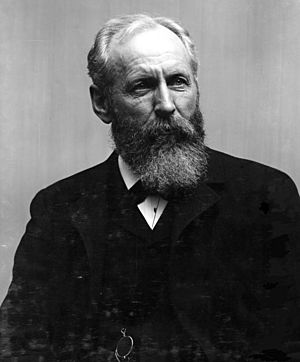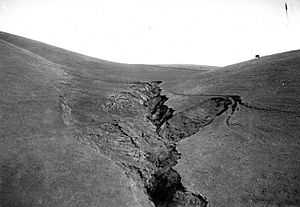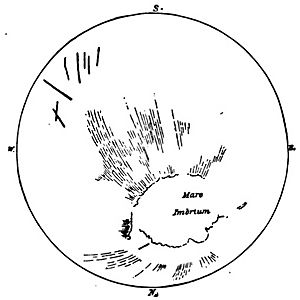Grove Karl Gilbert facts for kids
Quick facts for kids
Grove Karl Gilbert
|
|
|---|---|
 |
|
| Born | May 6, 1843 |
| Died | May 1, 1918 (aged 74) |
| Nationality | American |
| Alma mater | University of Rochester |
| Known for | Gilbert delta Crater studies Epeirogenic movement Geology of the Rocky Mountains Cycle of erroson |
| Awards | Wollaston Medal (1900) Charles P. Daly Medal (1910) |
| Scientific career | |
| Fields | Geology |
| Influenced | Willard Drake Johnson |
| Signature | |
Grove Karl Gilbert (born May 6, 1843 – died May 1, 1918) was an important American geologist. He was often known as G. K. Gilbert in scientific writings.
Contents
Biography of G. K. Gilbert
Gilbert was born in Rochester, New York. He later graduated from the University of Rochester. In 1871, he began working as the first geologist for George M. Wheeler's geographical survey team.
Exploring the Rocky Mountains
In 1874, Gilbert joined the Powell Survey. This survey explored the Rocky Mountain Region. He became Powell's main helper and stayed with the survey until 1879. During this time, he wrote an important book called The Geology of the Henry Mountains (1877).
After the U.S. Geological Survey was created in 1879, Gilbert became a Senior Geologist. He worked for the USGS until he passed away. He even served as the acting director for a time.
Gilbert also studied an ancient lake called Lake Bonneville in 1890. This huge lake existed during the Pleistocene Ice Age. Today, the Great Salt Lake is a small part of what was once Lake Bonneville. Gilbert named the lake after Captain Benjamin Bonneville, who had explored the area earlier. The special type of river delta that Gilbert described at this lake is now known as a Gilbert delta.
Studying Craters: Earth and Moon
In 1891, Gilbert looked into how a large hole in Arizona was formed. This hole is now famous as Meteor Crater. At the time, people called it Coon Butte. Gilbert thought it was made by a volcanic steam explosion. He did not believe it was from a meteorite impact.
Gilbert thought that if it was an impact crater, the meteorite's material should add to the crater's volume. He also expected to find magnetic signals if a large iron meteorite hit. His studies showed the crater's volume and the material thrown out were about the same. Also, there were no magnetic signals. So, he thought the small meteorite pieces found nearby were just a coincidence.
Later, in 1892, Gilbert shared his ideas about the Moon's surface. He wondered why lunar craters were round, even if impacts happened at an angle. He believed they were caused by impacts, not volcanoes. However, the idea that lunar craters were from impacts was also debated until the mid-1900s. Later research proved that Meteor Crater was indeed caused by a meteorite.
Understanding Earth's Surface: Geomorphology
In 1899, Gilbert joined the Harriman Alaska expedition. This trip explored parts of Alaska. Two weeks after the big 1906 San Francisco earthquake, Gilbert took many photos. These pictures showed the damage along the San Andreas fault.
Gilbert is seen as a very important person in geomorphology. This is the study of how Earth's surface changes. He helped us understand how landscapes form, how erosion works, how rivers cut into the land, and how sediment builds up.
He was also a pioneer in planetary science. He correctly figured out that craters on the Moon were caused by impacts. He even did early experiments on how impacts create craters. In 1893, he used the word sculpture to describe the patterns around a large lunar plain called Mare Imbrium. He correctly said these patterns were material thrown out from a giant impact. Gilbert was truly one of the most important early American geologists.
Awards and Recognition
Gilbert received many honors for his work. In 1900, he won the Wollaston Medal from the Geological Society of London. He became a member of the American Philosophical Society in 1902. In 1910, he was given the Charles P. Daly Medal by the American Geographical Society.
American geologists highly respected Gilbert during his lifetime. He is the only geologist to be chosen twice as President of the Geological Society of America (in 1892 and 1909). Because of his amazing ideas about planetary geology, the Geological Society of America created the G.K. Gilbert Award in 1983. This award is given for achievements in planetary geology.
To honor him, craters on the Moon and on Mars are named after him. Also, Mount Gilbert in Alaska and another Mount Gilbert in California bear his name.
See also
 In Spanish: Grove Karl Gilbert para niños
In Spanish: Grove Karl Gilbert para niños




